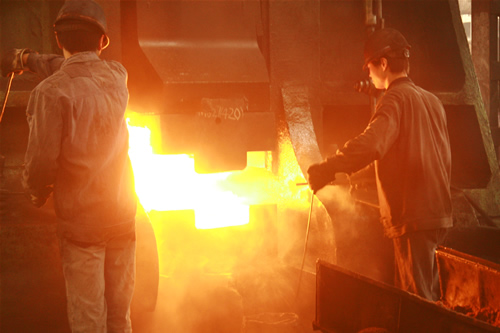Forging is one of metal pressure processing methods, referring to that use pressure to change the shape of metals so that can acquire forging pieces having mechanical property, shapes and dimensions.
The followings are the classifications of forging.
1. Hammer smith forging
The pattern of hammer forging is the same as blacksmithing. The work pieces are heated to the forging temperature, then, put between hammer flattener and drill plate for further forging. Small pieces can be made by hand, called as blacksmithing. Larger pieces need steam hammer. The work pieces are put between drill plate and hammer flattener. Structure of steam hammer is determined by forging capacity. Light one is single stand while heavy one is double stands.
2. Drop hammer forging
The difference between drop hammer forging and flat forging is that there is a mold cavity on hammer used for drop hammer forging. Work pieces suffer from two aspects of pressure or impact force in mold cavity, plastic deforming according to the shape of mold cavity. To ensure sufficient flowing of metal, forging is usually divided into several levels. Transformation in every level is gradual, advantageous for controlling flowing direction. Quantity of level depends on shape and dimension of forging pieces, forgeability of metal and precision of work piece.
3. Press forging
Press forging is a forging method that metal is extruded and formed inside mold under the pressure at a low speed. Due to metal stressed for a long time, extrusion is not only carried out on the surface of forging piece, but also carried out in center. Therefore, for even inside and outside, the quality of products is also better than that of drop hammer forging.
Forging used for manufacturing the shell of cellphone can reduce time of CNC effectively, having low relative cost. Moreover, aluminum alloy whose aluminum content exceeds 95% can be chosen for anodic oxidation.
Manufacturing process:
Firstly, acquire structural parts of cellphone having higher thickness;
Then, mill off the unnecessary parts through CNC, acquiring integrated structural members combining metal and plastic;
Treat surface with anodic oxidation;
Lastly, glue antenna cover.
4. Upset forging
Upset forging means that forge one of ends of an even long rod. Clamp the rod in the mold; heat one of end to high temperature. Force the end along the axial direction, upsetting and forming.
5. Roll forging
Use two round rollers (25%~75% reduction of diameter; the other part can be cut into groove shape based on requirements). Put rod into the two rollers and tight it, then, continue rotating, roll compacting the rod, reducing diameter and pushing it forward; when the rollers rotate to opening position again, withdraw the rod back to original position for the next cycle rolling, or send the rod to another grove for other construction.
